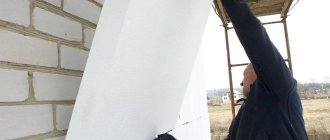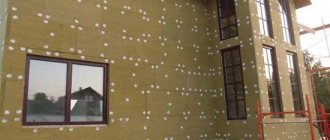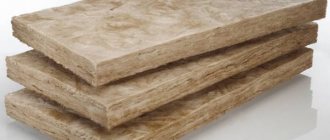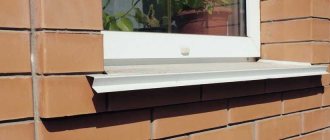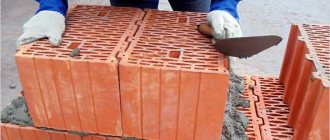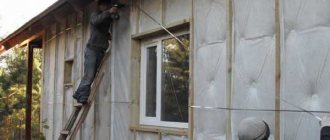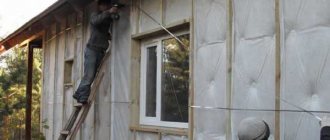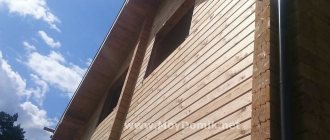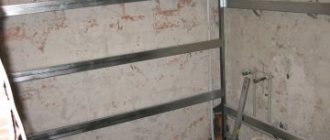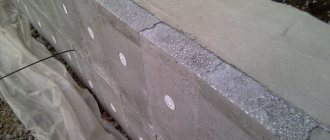Insulating the walls of a brick house from the inside
If it is not possible to insulate the home from the outside, experts recommend insulating the walls from the inside in a brick house. However, in order to make the right choice, you should pay attention to the characteristics of each material, especially vapor permeability, otherwise mold or mildew may appear on the brick wall surface under the insulation.
If it is not possible to insulate the home from the outside, experts recommend insulating the walls from the inside in a brick house.
When it is necessary to do this, indications for work
Thermal insulation outside the house is certainly more effective than insulation inside, however, there are situations when facade work is impossible. Factors that exclude facade work:
- The inability to change the façade of a building due to a ban due to the cultural or historical value of a given architectural structure;
- Lack of access to the facade if the nearest buildings are too close;
- When the object is located in an apartment building;
- Lack of the possibility of external thermal insulation in the design documents.
Without thermal insulation, brick walls will freeze, and the formation of a dew point in the masonry will lead to dampness and destruction of the entire structure.
Without thermal insulation, brick walls will freeze, and the formation of a dew point in the masonry will lead to dampness.
Composite selection
When choosing a material for thermal insulation from the inside of a room, you must first of all proceed from the indicators of vapor permeability and moisture absorption. Next, it is worth considering that seams and joint gaps are places where moisture escapes into the room and air enters the cold surface.
What won't work
Glass and mineral wool, liquid ceramics, balsa wood coverings, drywall, etc. are categorically unacceptable for this purpose.
Polystyrene foam forms many seams that require additional sealing, and also has a high moisture absorption rate. From the point of view of fire safety of a residential building, it is better not to use it, since it burns and releases toxic substances.
Polyurethane foam
It has excellent moisture protection and thermal insulation, as well as good adhesion on brick surfaces. The masonry does not require special processing or leveling. The only significant drawback is the complexity of installation.
Cured polyurethane foam is unstable to mechanical stress and requires additional protection. The moisture formation boundary will be either on the inner surface of the wall or in the thickness of the insulation. But due to the good sealing properties of polyurethane, condensation is not observed.
Expanded polystyrene
Among the available materials, polystyrene foam produced by high-pressure extrusion is also suitable. Although it is installed with the formation of a large number of joints, it has good indicators of moisture resistance and vapor permeability, and when it ignites, it smolders.
It is quite possible to install it yourself, without involving professional builders. But you should strictly adhere to the assembly technology and process stages.
Popular thermal insulators for interior work
Nowadays, internal insulation of brick walls can be carried out using different methods, which is why it is so important to correctly choose the most suitable material for these purposes, taking into account the characteristics of the given structure.
The material is selected taking into account its fire resistance, thermal conductivity and density. These indicators affect the weight of the material and the thickness of the insulation. And the duration of operation largely depends on the strength of the material.
The most popular insulation materials include:
- Expanded clay. This insulation is added to the base, after which a monolithic frame is formed from it;
This insulation is added to the base, after which a monolithic frame is formed from it. - Mineral wool. This insulation has good moisture absorption, so it allows you to insulate the house from the inside. Glass wool, which is also used as insulation, is one of the varieties of mineral wool;
This insulation has good moisture absorption, so it allows you to insulate the house from the inside. - Warm plaster. This material is a universal insulation material because it can be used both inside the house and for facade work. The insulation retains heat well, but it is a heavy material, so it is used only in houses with a reinforced foundation;
The insulation retains heat well, but it is a heavy material. - Cellulose wool. This material retains heat well, has excellent absorbency, but is subject to mechanical stress; experts recommend this insulation for interior work;
This material retains heat well and has excellent absorbency. - Cork insulation. The positive characteristics of the material include its ability to retain heat well, however, it is flammable;
The positive characteristics of the material include its ability to retain heat well. - Styrofoam. The reasonable price and the ability to use this material for both interior and facade work have made it popular. However, this insulation has disadvantages: it does not “breathe” and releases harmful compounds during the ignition process.
The reasonable price and the ability to use this material for both interior and facade work have made it popular.
Less popular insulation materials are: extruded polystyrene foam, penofol, penoplex, polyurethane foam and penoizol.
Criteria for choosing material, requirements for insulation, which is better
When choosing insulation of walls inside a brick house, first of all, it is necessary to take into account the thermal insulation properties of the material. In addition, the most significant characteristic of the material is vapor permeability.
The following actions will help prevent contact of freezing brick wall surfaces with steam:
- Wall cladding with a polymer heat insulator such as extruded polystyrene foam, sprayed polyurethane foam, high-density foam or penofol.
- Use of mineral wool insulation material.
- Applying a thick layer of heat-insulating plaster.
When planning to insulate your home, you should also consider the method of installing the heat insulator.
When choosing insulation of walls inside a brick house, first of all, it is necessary to take into account the thermal insulation properties of the material.
Content
Facade insulation will help maintain comfort and warmth in a half-brick house. External insulation is aimed at good heating of the walls and shifting the dew point to the outer surface. Thanks to this, condensation does not accumulate, which allows the previously wet wall to dry due to the divergence of steam.
Related article: How to soundproof a wall from neighbors
For thermal insulation of external surfaces, foamed polystyrene and polyurethane, gas-filled polymers are used. These materials have proven themselves to be excellent due to their moisture resistance, lightness, stable shape and strength.
DIY thermal insulation process
When planning to insulate your home with your own hands, you must strictly adhere to the rules of technology. To prevent such negative consequences as the formation of fungi, mold and destruction of brickwork, before installing insulation, the wall surface is plastered and special antifungal and antibacterial agents are applied to the walls. In addition, a brick house must have ventilation.
Methods for installing thermal insulation depend on the properties of the material used.
When planning to insulate your home with your own hands, you must strictly adhere to the rules of technology.
Insulation of brick walls from the inside with mineral wool
Since mineral wool is able to maintain the required temperature in the room, the use of such insulation is the most optimal solution. In some cases, mineral wool is used as additional insulation.
When deciding how to insulate a brick wall from the inside using mineral wool, it is important to take into account the order of work, which looks like this:
- Preparing a structure from a metal profile.
- Waterproofing material is installed on the sheathing.
- Mineral wool is placed tightly into the cells of the structure so that there are no gaps left.
- Next, the mineral wool is covered with a vapor barrier film membrane. Moreover, this layer is placed with the foil part inside the room. The vapor barrier material is fixed to a wooden lining or metal profile.
- Finishing the front part of the wall surface.
Since mineral wool is able to maintain the required temperature in the room, the use of such insulation is the most optimal solution.
Insulation of a brick house from the inside with polystyrene foam
When deciding which material to choose for insulating a building, you should pay attention to polystyrene foam, which has a high density. The insulation process is as follows:
- The sheets are glued directly onto a pre-leveled, primed wall surface. To improve adhesion, polystyrene foam is treated with a roller with a needle-shaped surface.
- The glue is applied to the sheets with a notched spatula, then they are glued so that the gaps are minimal.
- After the glue has dried, it is necessary to seal the seams.
- Then you can paste wallpaper on the walls or reinforce them with fiberglass mesh and plaster the surfaces.
Expanded polystyrene has a high density.
Insulation of a brick wall with polystyrene foam and plaster
The most budget-friendly, but labor-intensive method of thermal insulation is plastering the walls, which is carried out as follows:
- Before insulation work, it is necessary to clean the surface down to the brickwork and treat the walls with special antifungal and antibacterial impregnations.
- Then slats are fixed on the surface, onto which a metal mesh is attached.
- Next, the solution is applied to the walls.
The most budget-friendly, but labor-intensive method of thermal insulation is plastering the walls.
Modern insulation materials include polystyrene foam, which is fixed to a metal profile or to a wooden sheathing. The process includes the following steps:
- Surface cleaning.
- Treating walls with antifungal agents.
- If necessary, plastering is carried out.
- Fixing the sheathing.
- Fastening the insulation with glue or dowel nails with large heads in the sheathing compartments. Next comes sealing with foam.
Modern insulation materials include polystyrene foam, which is fixed to a metal profile or to a wooden sheathing.
Insulating a brick wall from the inside is not difficult to do yourself. However, in order for the house to become warm and cozy, it is important to choose the right insulation, taking into account the characteristics of the surface, familiarize yourself with the installation technology, including the nuances of working with each specific material and follow the recommendations of specialists, and you will succeed.
Features of independent thermal insulation of a half-brick building
When choosing future cladding, do not forget to take into account the type of material from which the building is built, the seasonality of people living in it and the type of insulation - internal or external.
There are a number of reasons why it is better to insulate a house from the outside:
- there is no change in the usable living area of the rooms;
- the initial level of tightness of the building material does not change;
- reliable protection against temperature surges;
- the original masonry will be reliably preserved from rodents and insects;
- the operational life of the building is extended.
Thermal insulation using mineral wool
The structure of the material is quite rigid, which allows you to cut mineral slabs with a saw, hacksaw or just a sharp knife. It is not recommended to use scissors, as they compress the material being cut and the integrity of the insulator structure is compromised. To make the insulation fit more tightly, when cutting, you should leave a reserve of material in the range of 0.5-2 centimeters.
Mineral wool in rolls is cut without unrolling it. Slab options are cut separately from each other. The recommended thickness of the insulating layer should be over 10 centimeters.
- Mineral wool slabs are prepared, according to the dimensions of which a wooden frame is mounted. The wall is treated with an adhesive solution, the cells are filled with insulation boards. Insulation from moisture and cold must be installed between the outer and inner walls of the building. Then you can start creating the brick cladding.
- The basis for fastening mineral wool will be special anchors mounted along the contour of the main masonry of the building. The insulation is laid on the walls, after which it is fixed using clamps. Brick cladding is done while maintaining a small gap, after which the existing seams can be leveled and grouted. The building can be faced using siding or an additional layer of plaster. It is laid on top of the reinforcing mesh and painted.
Thermal insulation with foamed polystyrene
The cladding of the external walls of the building begins with the assembly of a wooden frame. The thickness of the insulating material should match as closely as possible the thickness of the slatted base. The surface of the wall should have a rough texture, then it will be easy to apply a special adhesive solution to it for installing fragments of insulation. Metal corners are mounted on the anchors, the joints are joined using mounting tape, and then rubbed down. Then a special film is attached to serve as protection from wind and moisture. Leave a gap for ventilation of 3 to 5 centimeters.
All that remains is to plaster the facade and cover it with siding.
Polyurethane foam insulation
This method will effectively improve the thermal insulation of a half-brick house. A metal mesh should be installed on top of the brick or foam block masonry. If the insulation surface is small, you may not need to install additional fasteners. Foamed polyurethane is applied using a specialized device that heats and sprays it. The material quickly expands, effectively filling all existing voids and cavities. Once cooled, it becomes smooth and hard. An adhesive solution and a reinforcing mesh are applied to the insulator layer. Then the surface is covered with plaster and painted. The material adheres perfectly to any surface, leaving almost no excess after completion of the work.
This method of thermal insulation can significantly reduce the thickness and weight of the structure being built.
